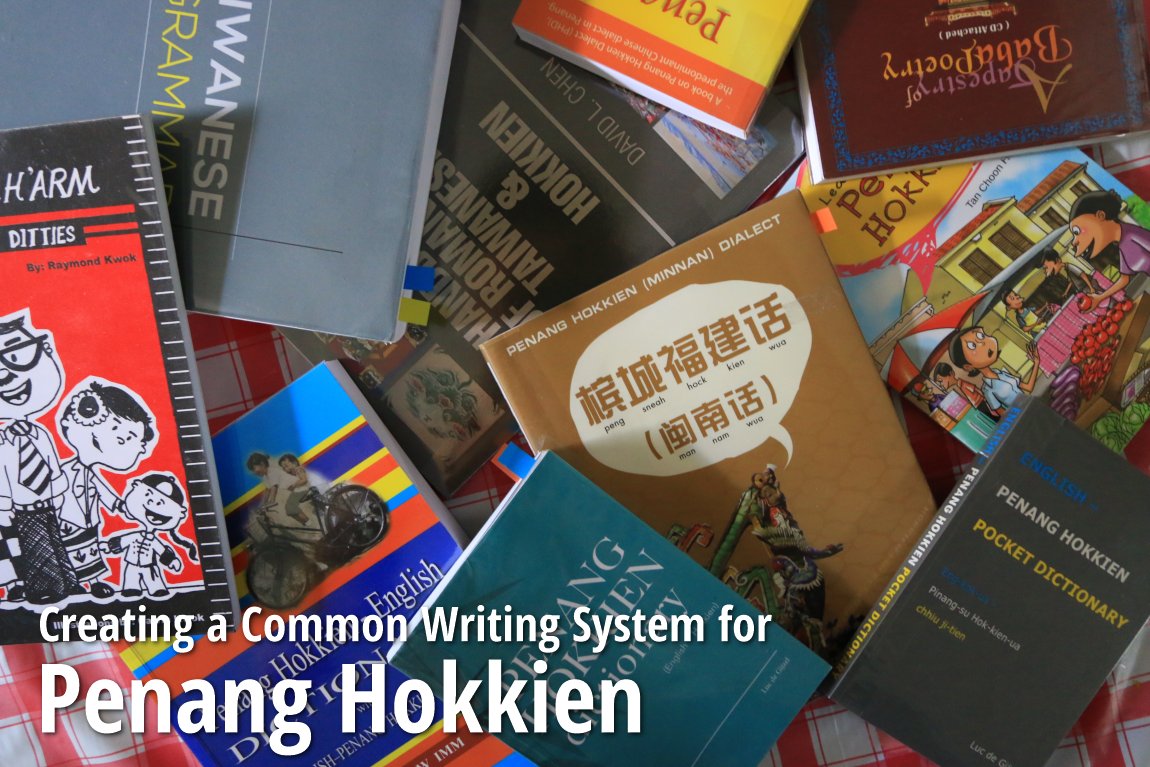 Creating a Common Writing System for Penang Hokkien (8 September, 2016)
Creating a Common Writing System for Penang Hokkien (8 September, 2016)There are many Penang Hokkien-speaking people who agree that there has to be a writing system for communication in the language. Even though Penang Hokkien has existed all this while as a largely spoken language, the need to establish a writing system for it has become more acute in the 21st century, where society has become more accustomed to written communication, particularly through telecommunication. However, as of now, there is now united approach over which writing system to adopt for Penang Hokkien. As a result, as many as five different approaches are being championed by various groups, each with the same desire of preserving Penang Hokkien.
The five different approaches can be sequenced according to difficulty and the demands expected of the learner in picking up the system. The more difficult the system, the more hours would be required by the Penang Hokkien speaker to become literate in it.
The first approach, taken by many Penang Hokkien authors, as well as the majority of Penang Hokkien speakers, is to rely on transcription. Every person attempting to write Penang Hokkien transcribes the sounds and spells the words out according to his interpretation. The benefit of transcription is that there are few rules to learn. However, as transcription system does not indicate tones, only people who are already speaking Penang Hokkien are able to understand what has been written, and can read the transcribed text with the correct intonation.
The second approach, which is taken by myself, is to adopt spelling patterns that are commonly accepted from the transcription system, and create a homegrown orthography for Penang Hokkien, incorporating elements from English, Malay and Mandarin. The result is Taiji Romanisation, which was created in 2013, and which is the system I continue to champion. The benefit of this system is that it relies on spelling traditions that are familiar to local speakers, while incorporating rules for intonation and tone sandhi.
The third approach is to adopt a system that was established elsewhere, to establish a universal system for writing Hokkien that includes Hokkien dialects such as Penang Hokkien. Leveraging on the soft infrastructure that is being put in place for the writing of Taiwanese Hokkien, this group champions the use of Taiwanese Romanisation, also called Tâi-lô, for writing Penang Hokkien. The benefit of this system is that there is likely to be more soft media produced using Taiwanese Romanisation, albeit from Taiwan.
The fourth approach is to continue using the form of romanisation that has been in place for generation, which is known as Church Romanisation or Pe̍h-ōe-jī. This is the orthography established by Christian missionaries in the late 19th century. It has the benefit of an existing body of printed matter already using this system going back generations, including dictionaries and Bibles. In addition, all the latest dictionaries for Penang Hokkien use Church Romanisation.
The fifth approach to writing Penang Hokkien is to champion the rejuvenation of using Chinese characters, the argument being Chinese characters have been the way to write Hokkien all along, and is how Hokkien appears on various plaques for temples and clan houses. The benefit of this approach is that those who become literate in this system will be able to make sense of existing material - albeit sporadic - that is written using Chinese characters.
It goes without saying that every one of the five approaches has its own drawbacks. Often those who champion one approach are in denial of the drawbacks and weaknesses of his approach. Nevertheless, the survival of Penang Hokkien as a spoken language, and its chances of developing into a written language, is enhanced by the interest and passion of those championing the various approaches.
 Latest updates on Penang Travel Tips
Latest updates on Penang Travel Tips
 Map of Roads in Penang
Map of Roads in Penang
Looking for information on Penang? Use this Map of Roads in Penang to zoom in on information about Penang, brought to you road by road.Disclaimer
Please use the information on this page as guidance only. The author endeavours to update the information on this page from time to time, but regrets any inaccuracies if there be any.
Copyright © 2003-2025 Timothy Tye. All Rights Reserved.

 Go Back
Go Back